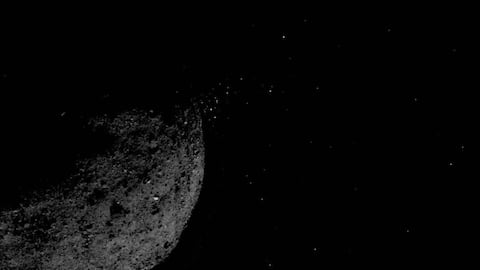Why is near-Earth asteroid Bennu's 'soft surface' puzzling NASA scientists
What's the story
Two years after its OSIRIS-REx spacecraft collected samples from asteroid Bennu, NASA has revealed something astonishing about the asteroid's surface.
According to the space agency, the particles making up Bennu's surface are so loosely packed and lightly bound that a person stepping onto the asteroid would feel very little resistance.
Bennu was first discovered by scientists in 1999.
Context
Why does this story matter?
Ever since its discovery, Bennu has been considered a threat to Earth. A strike by Bennu would cause continent-wide disruption.
Now that we have understood that the surface of Bennu is unlike other solid asteroids, we may have to devise a new deflection strategy.
The new finding also gives us a better insight into asteroids around us.
Surprise
The spacecraft sank 30-inch after touching down on the asteroid
Scientists associated with the OSIRIS-REx were surprised when the spacecraft landed on Bennu in October 2020. Despite the gentle landing, the spacecraft sank as deep as 30-inch (70cm).
Dante Lauretta, the principal investigator of the spacecraft said, "there clearly was no resistance whatsoever. The surface was soft and flowed away like a fluid."
A mass of gravel and dirt ejected when the spacecraft landed.
Dramatic
OSIRIS-REx's operators were left frightened by the events on Bennu
OSIRIS-REx's mission on Bennu was nothing short of dramatic. Mission scientists expected the asteroid to be rigid.
However, the spacecraft's landing created a 26-foot-wide (8m) gaping hole at the site called 'Nightingale.' The touch-down caused an explosion that saw a giant wall of debris flying away from the sample side.
About the event, Lauretta said, "For spacecraft operators, it was really frightening."
Findings
Density of Bennu's surface material is very less
The findings of OSIRIS-REx's mission on Bennu were revealed in two papers by Lauretta and another researcher named Kenny Walsh.
Stepping on the surface of the asteroid was likened to entering a pit of plastic balls due to the very little resistance it offered.
The density of the surface material was only 500-700kg/cubic meter, much less than a typical Earth rock (3,000kg/cubic meter).
What's inside?
Interior of the asteroid may have organic molecules
Scientists found that the surface boulders on Bennu are very porous and have a lot of void space between them.
The surface of the asteroid appeared bluish, while the interior appeared redder. The blue color of the surface is a result of cosmic rays and space weather.
The red hue, however, is interesting, as it hints at the presence of organic molecules like hydrocarbons.
Unknown
Asteroids like Bennu are still a puzzle
Asteroids like Bennu, barely held together by gravity or electrostatic force, could pose a different threat than solid asteroids.
Scientists assume that many other asteroids sport a similar "rubble pile" structure of conglomerations of rock, gravel, and dirt.
"I think we're still at the beginning of understanding what these bodies are, because they behave in very counterintuitive ways," said Patrick Michel, an OSIRIS-REx scientist.
Information
The spacecraft will deliver sample from Bennu next year
OSIRIS-REx managed to collect almost 250g of asteroid Bennu's dust, four times more than what's needed for analysis. The sample is scheduled to be delivered by September 2023. After delivery, the spacecraft will head to Apophis, another high-risk asteroid.
